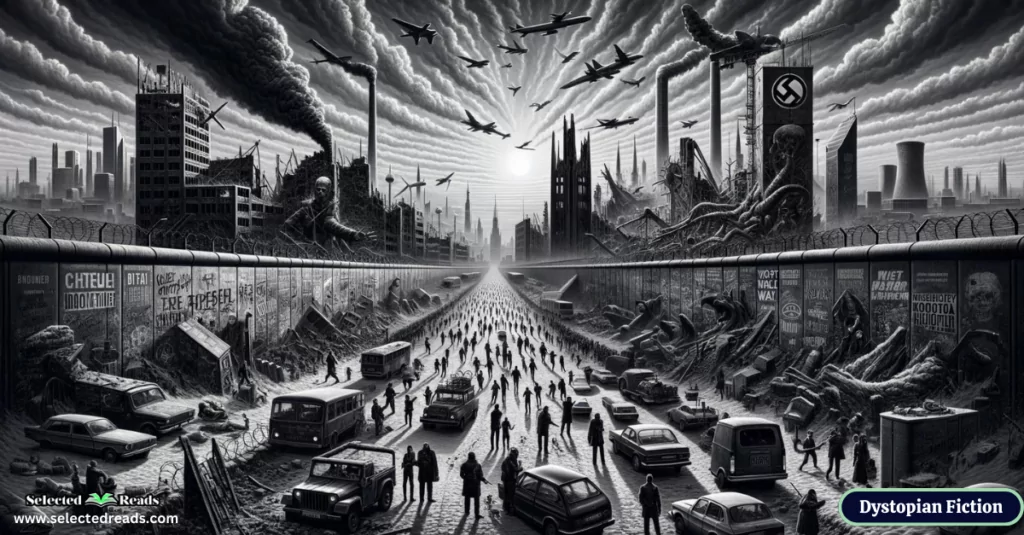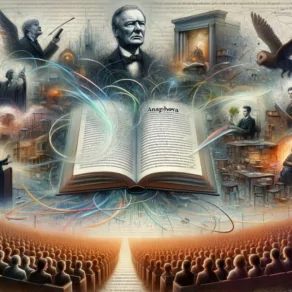Dystopian fiction, a genre that often presents a grim and unsettling vision of the future, serves as a mirror reflecting our deepest fears about society’s current trajectory. Through the imaginative lens of dystopia, authors explore the consequences of societal flaws and human follies, extrapolating them into future worlds where these elements are magnified into stark, often horrifying realities.
In this post, we will explore the intricate world that makes up dystopian fiction. We’ll begin by defining the genre, outlining its characteristics, and discussing why it continues to captivate and alarm readers. Following this, we’ll dive into some of the central themes that dystopian works often grapple with, including the dangers of unchecked political power, the erosion of privacy in the digital age, the environmental consequences of our neglect, and the ethical dilemmas presented by scientific progress.
To bring these themes to life, we’ll cover a range of examples from the genre, starting with Margaret Atwood’s seminal work, “The Handmaid’s Tale,” a harrowing tale of a future where women are subjugated by a theocratic regime. From the classic alarm bells of George Orwell’s “1984” to the more recent societal reflections in Suzanne Collins’ “The Hunger Games,” we’ll examine how these narratives serve as cautionary tales about the potential dark paths our society could take.
Through this post, we aim to provide a comprehensive overview of dystopian fiction, highlighting its importance as a genre that not only entertains but also challenges us to reflect critically on the direction in which we are headed.
Utopian Vs Dystopian Fiction
Utopian and dystopian fiction are branches of speculative fiction that delve into imagined societies, often highlighting the contrast between ideal and flawed worlds. Utopian fiction paints a picture of a society that embodies the author’s vision of perfection, offering readers a glimpse into a world where societal norms and practices align with idealistic principles.
Dystopian fiction, on the other hand, presents a starkly different vision—a society that starkly contradicts the author’s ideals, often depicting settings rife with inequality, oppression, and despair. These narratives serve not only as reflections of the author’s views but also as commentary on the potential paths society could take, depending on the choices made by humanity.
Andrew Hammond (2011) discusses how dystopian fiction served as a critical reflection of Cold War tensions and anxieties from 1945 to 1989, positioning it as a genre deeply intertwined with the geopolitical dynamics of the era. Far from being detached, dystopian literature of the mid-20th century was fundamentally engaged with the prevailing geopolitical currents, particularly the fears and ideological conflicts spurred by the Cold War.
This genre, according to the author, flourished as a form of admonitory literature that vividly intensified current trends to warn against potential dystopian futures, motivated by the period’s idealistic political blueprints for change.
This engagement with contemporary issues was not new but saw a significant intensification post-World War II amidst growing disillusionment with political idealism, fueled by the atrocities of the Holocaust, Stalinist regimes, and the expansion of US hegemony.
Critics like Robert Elliott and Mark Hillegas have underscored this shift, viewing the decline in utopian faith as indicative of broader societal anxieties. The term ‘dystopia’ itself, as Hammond explained, highlights this genre’s role in critiquing imagined perfections and reflecting fears of a catastrophic future if current issues are not addressed, making dystopian fiction a pivotal medium for exploring and critiquing the “worst of all possible worlds” as a tangible historical reality, especially in post-1945 Eastern Europe.
Dystopian Fiction Themes
Dystopian fiction explores a range of themes that reflect the anxieties and challenges of society. These themes often serve as warnings or critiques of current trends, extrapolating them into future scenarios where their negative consequences are amplified. Common themes in dystopian fiction include:
- Totalitarianism and Oppression: Many dystopian narratives feature societies under the control of oppressive governments or organizations, highlighting the dangers of authoritarianism and the loss of individual freedoms.
- Surveillance and Privacy: The erosion of privacy in the face of pervasive surveillance is a recurrent theme, depicting worlds where citizens are constantly monitored by the state or corporations.
- Environmental Degradation: Dystopias often portray Earth in the aftermath of environmental catastrophes, emphasizing the consequences of ecological neglect and unsustainable living.
- Technological Control and AI: The unchecked advancement of technology and artificial intelligence is a common concern, with stories exploring how these tools can lead to dehumanization and societal control.
- Social Inequality and Class Division: Dystopian fiction frequently examines the disparities between different social classes, showing how wealth and power can lead to deep societal divisions and exploitation.
- Loss of Individuality: Many dystopias explore the suppression of individual expression and identity, with societies enforcing conformity and discouraging or punishing uniqueness.
- Corruption and Decay: The corruption of societal institutions and moral decay are often central, illustrating how greed, corruption, and ethical compromises can lead to societal downfall.
- Resistance and Rebellion: Despite the grim settings, dystopian stories often include themes of resistance, hope, and the struggle for freedom, highlighting the resilience and courage of individuals or groups fighting against oppressive systems.
- Manipulation and Propaganda: The use of propaganda to manipulate public opinion and maintain control is a frequent theme, demonstrating the power of media and misinformation in shaping societal beliefs and actions.
- Genetic Engineering and Bioethics: Questions surrounding bioengineering, eugenics, and the manipulation of human genetics are explored, raising ethical concerns about the boundaries of scientific experimentation.
Dystopian Fiction Examples
Margaret Atwood’s “The Handmaid’s Tale” is a prime example of dystopian fiction, set in the theocratic dictatorship of Gilead where women are stripped of their rights and freedoms. This novel explores themes of oppression, gender inequality, and the misuse of religion for political control. Following are other notable examples of dystopian fiction, each addressing various themes reflective of societal anxieties and critiques:
- George Orwell’s “1984” – A classic in dystopian literature, this novel presents a totalitarian regime where surveillance, newspeak, and thought control are used to maintain the Party’s power, exploring themes of government surveillance, totalitarianism, and the manipulation of truth.
- Aldous Huxley’s “Brave New World” – Set in a future where society is engineered for happiness and efficiency, but at the cost of individuality and emotional depth. It delves into themes of technological control, consumerism, and the sacrifice of individuality for societal stability.
- Ray Bradbury’s “Fahrenheit 451” – In a society where books are banned and “firemen” burn any that are found, this story explores the suppression of dissenting ideas, censorship, and the loss of intellectual freedom.
- Suzanne Collins’ “The Hunger Games” – A young adult series set in a post-apocalyptic world where the Capitol exerts control over the districts through a televised fight to the death. Themes include social inequality, oppression, and the spectacle of violence as entertainment.
- Cormac McCarthy’s “The Road” – A post-apocalyptic tale of a father and son traveling through a burned America, this novel delves into themes of survival, the bond between parent and child, and the remnants of civilization in a world of desolation.
- Margaret Atwood’s “Oryx and Crake” (The MaddAddam Trilogy) – Another work by Atwood, this series explores a world devastated by genetic engineering and climate change, addressing environmental destruction, bioengineering ethics, and corporate power.
- Lois Lowry’s “The Giver” – Set in a society that has eliminated pain and strife by converting to “Sameness,” a plan that also eradicates emotional depth from their lives. It tackles themes of conformity, the importance of memory and emotion, and the loss of individuality.
Final thoughts
Dystopian fiction, through its exploration of totalitarian regimes, technological overreach, environmental devastation, and the erosion of individual freedoms, offers more than just a speculative glance into possible futures; it acts as a crucial commentary on our present, urging readers to consider the implications of our actions today to avoid the grim realities it portrays.
The themes and examples discussed in this post underscore the genre’s enduring relevance and its ability to challenge, provoke, and inspire its audience. By presenting extreme outcomes of humanity’s current path, dystopian fiction holds up a dark mirror to our world, compelling us to confront uncomfortable truths about society and ourselves.
It encourages a critical examination of our values, our governance, and the impact of our technological advancements, making it a genre that is not only engaging but also immensely important in fostering dialogue and reflection on the direction of human progress.
Sources:
- Andrew Hammond. (2011). ‘The Twilight of Utopia’: British Dystopian Fiction and the Cold War. The Modern Language Review, 106(3), 662–681. https://doi.org/10.5699/modelangrevi.106.3.0662
- Utopian and Dystopian Fiction, Wikipedia, https://en.wikipedia.org/wiki/Utopian_and_dystopian_fiction
- Dystopian Novel, Britannica, https://www.britannica.com/art/dystopian-novel







